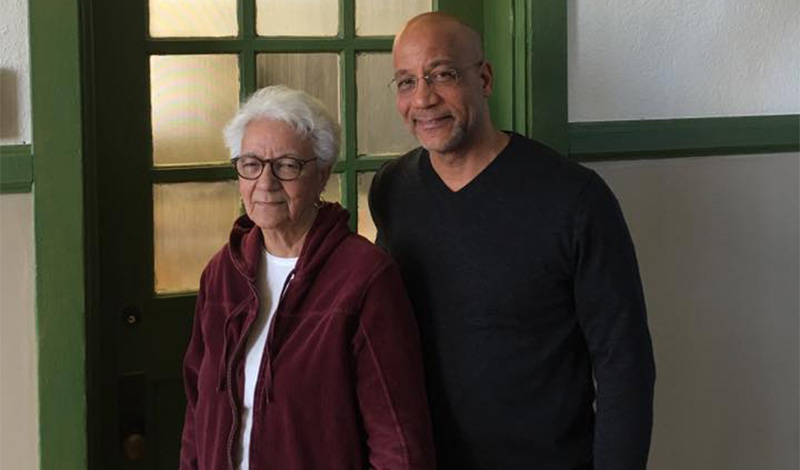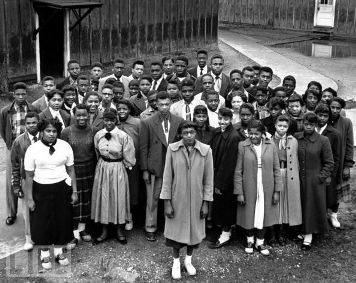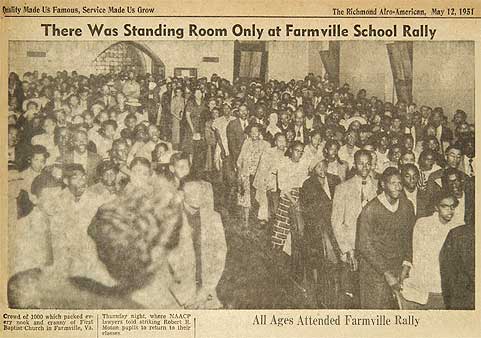

Farmville continues to make history as we delve into Black History Month with a recent visit to the R.R Moton Museum by Mrs. Ann Vaughan Hammond and Dr. M.G. Cary, the daughter and grandson of Mrs. Dorothy Vaughan.
Does the name Dorothy Vaughan ring a bell? She was a teacher at R.R Moton High School in Farmville who later worked as a mathematician for the National Advisory Committee for Aeronautics and NASA at the Langley Research Center in Hampton, Virginia. Her story is featured in the book and Oscar-nominated film “Hidden Figures.”
“Dorothy Vaughan came to the Langley Memorial Aeronautical Laboratory in 1943, during the height of World War II, leaving her position as the math teacher at Robert Russa Moton High School in Farmville, Virginia, to take what she believed would be a temporary war job. Two years after President Roosevelt signed Executive Order 8802 into law, prohibiting racial, religious and ethnic discrimination in the country’s defense industry, the Laboratory began hiring black women to meet the skyrocketing demand for processing aeronautical research data. Urgency and 24-hour shifts prevailed – as did Jim Crow laws which required newly hired “colored” mathematicians to work separately from their white female counterparts.” – NASA.gov
The former Robert Russa Moton High School in Farmville is now a National Historic Landmark, museum and civil rights monument documenting a young student’s fight for her rights and for the rights of her fellow students.
 In 1951, Barbara Johns, a 16-year-old student at R.R Moton High School, walked out of class to protest the conditions at the school, which were said to be vastly inferior to those of the white students at nearby Farmville High School. The strike helped spark the desegregation movement in America, leading to the famous Brown v. Board of Education case. For more information, visit motonmuseum.org.
In 1951, Barbara Johns, a 16-year-old student at R.R Moton High School, walked out of class to protest the conditions at the school, which were said to be vastly inferior to those of the white students at nearby Farmville High School. The strike helped spark the desegregation movement in America, leading to the famous Brown v. Board of Education case. For more information, visit motonmuseum.org.
R.R. Moton Historical Timeline:
Timeline facts brought to you by encyclopediavirginia.org:
- April 23, 1951 – Under the leadership of Barbara Johns, fellow students at the all-black Robert Russa Moton High School in the town of Farmville in Prince Edward County walk out of their school to protest the unequal conditions of their education as compared to those of the white students in nearby Farmville High School.
- April 26, 1951 – Virginia NAACP Executive Secretary Lester Banks meets with students of the all-black Robert Russa Moton School and their parents, telling them that the NAACP is willing to take on their case in an attempt to end segregation.
- May 23, 1951 – The NAACP files the suit Davis, et al. v. County School Board of Prince Edward County, Virginia, in federal court, challenging the constitutionality of segregated education in Prince Edward County schools on behalf of black students and their parents.
- December 1952 – U.S. Supreme Court hearings begin in the case of Brown v. Board of Education of Topeka, Kansas, which is actually five cases from across the country bundled together including the Virginia case of Davis, et al. v. County School Board of Prince Edward County.
- May 17, 1954 – The U.S. Supreme Court rules in Brown v. Board of Education of Topeka, Kansas, that segregation in schools is unconstitutional, but fails to explain how quickly and in what manner desegregation is to be achieved. The decision leads to the Massive Resistance movement in Virginia.
- June 26, 1959 – After eight years of court cases and delays related to school desegregation, the Prince Edward County Board of Supervisors votes not to fund public schools in the 1959–1960 school year.
- March 28, 1962 – Martin Luther King Jr. visits Prince Edward County.
- March 18, 1963 – U.S. attorney general Robert F. Kennedy says during a speech: “the only places on earth not to provide free public education are Communist China, North Vietnam, Sarawak, Singapore, British Honduras—and Prince Edward County, Virginia.”
- May 25, 1964 – After Prince Edward County’s public schools have been closed for the previous five years, the U.S. Supreme Court in Griffin v. School Board of Prince Edward County rules that the county has violated the students’ right to an education and orders the Prince Edward County schools to reopen.
- September 8, 1964 – About 1,500 students, all but eight black, attend classes in the Prince Edward County public schools for the first time in five years.
- August 31, 1998 – Robert Russa Moton High School is placed on the National Register of Historic Places by the U.S. secretary of the interior, the highest level of historical recognition offered by the federal government.
- April 23, 2001 – The Robert Russa Moton Museum for the study of civil rights in education opens in the former Moton High School on the fiftieth anniversary of the school strike for equal facilities for black students in Prince Edward County.

